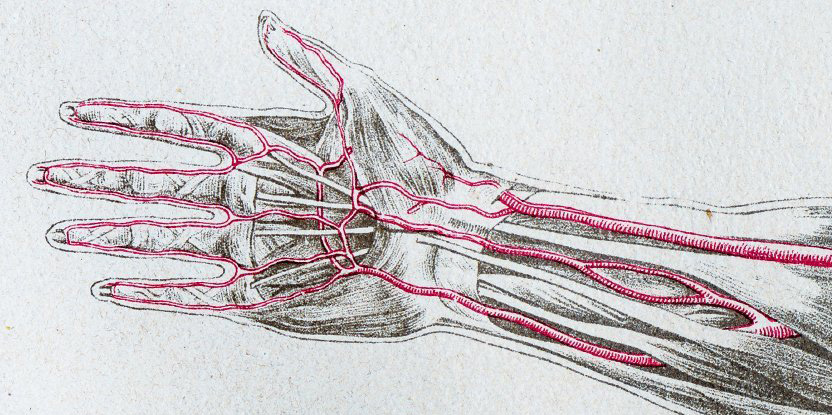
Posted on 10/09/2020 11:03:16 AM PDT by Red Badger

Picturing how our species might appear in the far future often invites wild speculation over stand-out features such as height, brain size, and skin complexion. Yet subtle shifts in our anatomy today demonstrate how unpredictable evolution can be.
Take something as mundane as an extra blood vessel in our arms, which going by current trends could be common place within just a few generations.
Researchers from Flinders University and the University of Adelaide in Australia have noticed an artery that temporarily runs down the centre of our forearms while we're still in the womb isn't vanishing as often as it used to.
That means there are more adults than ever running around with what amounts to be an extra channel of vascular tissue flowing under their wrist.
"Since the 18th century, anatomists have been studying the prevalence of this artery in adults and our study shows it's clearly increasing," says Flinders University anatomist Teghan Lucas.
"The prevalence was around 10 percent in people born in the mid-1880s compared to 30 percent in those born in the late 20th century, so that's a significant increase in a fairly short period of time, when it comes to evolution."
The median artery forms fairly early in development in all humans, transporting blood down the centre of our arms to feed our growing hands.

Three major arteries in the forearm - median in the centre
At around 8 weeks, it usually regresses, leaving the task to two other vessels – the radial (which we can feel when we take a person's pulse) and the ulnar arteries.
Anatomists have known for some time that this withering away of the median artery isn't a guarantee. In some cases, it hangs around for another month or so.
Sometimes we're born with it still pumping away, feeding either just the forearm, or in some cases the hand as well.
To compare the prevalence of this persistent blood channel, Lucas and colleagues Maciej Henneberg and Jaliya Kumaratilake from the University of Adelaide examined 80 limbs from cadavers, all donated by Australians of European descent.
The donors raged from 51 to 101 on passing, which means they were nearly all born in the first half of the 20th century.
Noting down how often they found a chunky median artery capable of carrying a good supply of blood, they compared the figures with records dug out of a literature search, taking into account tallies that could over-represent the vessel's appearance.
The fact the artery seems to be three times as common in adults today as it was more than a century ago is a startling find that suggests natural selection is favouring those who hold onto this extra bit of bloody supply.
"This increase could have resulted from mutations of genes involved in median artery development or health problems in mothers during pregnancy, or both actually," says Lucas.
We might imagine having a persistent median artery could give dextrous fingers or strong forearms a dependable boost of blood long after we're born. Yet having one also puts us at a greater risk of carpal tunnel syndrome, an uncomfortable condition that makes us less able to use our hands.
Nailing down the kinds of factors that play a major role in the processes selecting for a persistent median artery will require a lot more sleuthing.
Whatever they might be, it's likely we'll continue to see more of these vessels in coming years.
"If this trend continues, a majority of people will have median artery of the forearm by 2100," says Lucas.
This rapid rise of the median artery in adults isn't unlike the reappearance of a knee bone called the fabella, which is also three times more common today than it was a century ago.
As small as these differences are, tiny microevolutionary changes add up to large-scale variations that come to define a species.
Together they create new pressures themselves, putting us on new paths of health and disease that right now we might find hard to imagine today.
This research was published in the Journal of Anatomy.
Sorry, but the cornerstone of Darwinistic faith has one critter turning into whole another critter. Outside of cartoons, Chuck Darwin’s claims and other fairytales that just has never happened.
Funny how none of that evidence reaches a peer reviewed journal. It doesn’t exist.
Does a new trait present itself? Is DNA modified and passed on to offspring? Yeah, didn’t think so.
Evolution is a fairy tale to simply replace a loving creator God with a cold, dead accident called time. Problem is accidents never create organization, just entropy.
Unfortunately for your theory, there is no evidence of such occurring.....
OK
You apparently don’t read peer reviewed journals.
Not according to the creation research institute, no.
Yikes.
As a kid I loved Outer Limits and Twilight Zone, but that episode was THE scariest.
There’s a range and always has been, with these vessels.
Survival will no longer be an issue because almost all of us have passed the subsistence level of income. Therefore, the weeding out of disadvantageous mutations, and the expansion of advantageous mutations no longer works. Almost all humans live to reproduction age and there is a concern for increasing numbers of congenital disorders since survival of the fittest is gone as a check on the same.
Having said this, new species have emerged in abundance soon after extinction events, such as the one that wiped out the dinosaurs. In the space of a few million years, many new species emerge from whatever traces of life that survived. The renewal of life with great diversity is more like a miracle than the workings of the accumulation of small mutations that eventually differentiate one from another species.
It was likely a genetic thing.
“Indeed a genetic basis for longevity has been demonstrated in animals, e.g. fruit flies, such that genes for longevity can be lost from a population.”
“Recent advanced computer simulations vindicate this proposal, showing that an exponential decay of lifespans fits well with accumulating mutations after the catastrophic population bottleneck at the Flood.”
https://creation.com/living-as-long-as-methuselah
We are obviously not on same terms. Macro evolution has NEVER been seen, proven, or duplicated.
Good point! I didn’t consider the Flood.
So, show me. I do live in Missouri....
New species, but no intermediates?
That defies the entire premise that your ideology is based on. Evolution must show gradual improvement, not exponential or astronomical changes.
Baloney.
I don’t think anybody believes in the theory of the accumulation of many individually small mutations leading eventually to new species. That was the theory I was taught back in grammar, nearly 60 years ago. The current theory is called “punctuated equilibrium, and sounds like a miracle theory of the diversity of life. The “tree” of life has been replaced by a “bush.”
I saw a picture of Lincoln the other day with him standing in a crowd of a couple of dozen military officers. He was a head taller than anyone there. To make him even imposing, he was wearing a stovepipe hat.
Umm. Okay.
What is actually observed is just that, but turned upside down.
Dogs, cats, bovine, primate, amphibs, etc.
Then, variation based in isolated populations and beneficial traits becoming common.
Think rabbits. Varying hares etc.
Look at dogs, man manipulates/isolates if you will, for wanted traits. They become “breeds”. But all dogs. They can reproduced across all breeds. All dogs.
The evolution theme is just an unreasoned attempt at denying a creator and replacing Him with time, making man just an animal. Its a religion.
I am aware of the Hindu teachings in occultism, but in america a third eye on yourforehead is a fat pimple.
Disclaimer: Opinions posted on Free Republic are those of the individual posters and do not necessarily represent the opinion of Free Republic or its management. All materials posted herein are protected by copyright law and the exemption for fair use of copyrighted works.